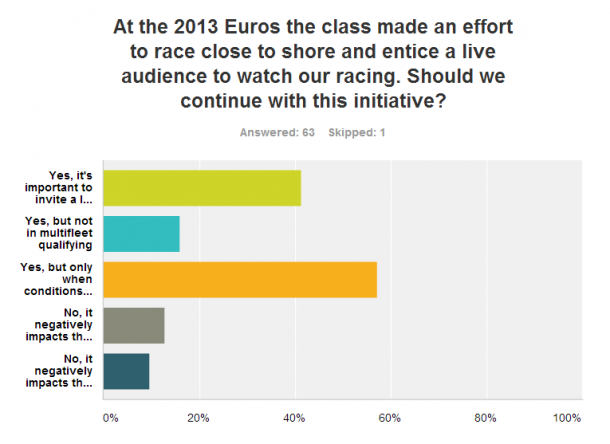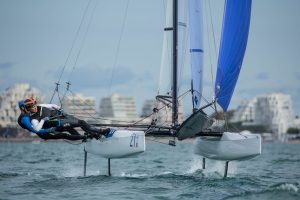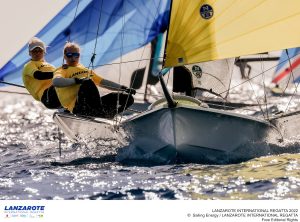Immediately following the 2013 SAP 49er & 49erFX European championship a survey has been circulated to all of the 49er and 49erFX sailors. It asks a number of questions about how best to set up 49er championships. One of the more comprehensive responses is on the question of should we race close to shore and close to spectators. Here is how the class is weighing in.
With 64 people having completed the survey, over 70% of sailors say that yes, 49er should race close to shore. Not sure why the numbers don’t add up right here, must have selected that people can choose multiple answers or something…. but interestingly, the strongest single answer is ‘Yes, but only when conditions allow.’
So where do the sailors stand on “only when the conditions allow?” Are we talking about normal sailing conditions, say 5-25 knots and an RC judgement that ‘fair sailing’ conditions exist? Is that the only criteria or are we talking about more subjective conditions, like the variability of wind strength between the top and bottom of the course, the shiftiness, and other factors? Given what we just saw in Denmark, where we saw both on shore and offshore breezes on the championship course, we should be able to have a fairly accurate discussion about this so that everyone is on the same page for planning future championships.
From a sailors point of view, ‘only when conditions allow’ is an understandable response yet there are a few ways to interpret that point. Lets discuss this so we all have the same interpretation and that way organizers, fans, and sponsors can respond accordingly.
Done properly, live sailing can be exciting for fans to view in close proximity to the racing. We saw this at the Nothe Course in Weymouth 2012. Like all live sporting venues, the public expects certain amenities to aid in their viewing experience, and that’s where the issues might start to rise within the answers from the sailors.
There are the basics, food, water, shelter, and restroom facilities. If we are to gain a following people will want to buy food and drinks, a hot dog and beer garden as a minimum. We’ll have to have portolets, maybe some shade, and things like that, the real basic amenities.
There is also the time people spend to come and watch us racing, and the time spent to reach out and inform those people that there is racing to watch. It takes an advertising budget, radio spots, city center banners, etc., so that people know there is a regatta to come and see.
The sporting public expects even more than that, however. They expect, and we should try to deliver, a PA announcer to explain what is going on, music in between races, a large screen to watch the racing when it is at the far end of the course, scoreboards to keep track of what place everyone is in, and much more. If the 49er class was really ambitious we might even set up some demo boats so that the public can get out on a 29er for a ride, maybe through some sort of draw or competition. Creating an ‘event’ on shore is a challenging task, and one that must be thoroughly planned to be done right.
All of these things are going to cost the organizers money, which will largely fall to either sponsors or ticket sales to cover. Given that a big screen TV is roughly 30,000 euros for a weekend including the set up, a budget of 50,000 euros minimum is required to put together a great offering for the viewing public. With either sponsors or ticket sales covering the expenses, they are going to have some demands for those dollars.







